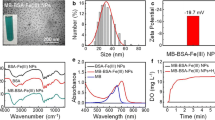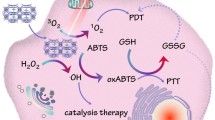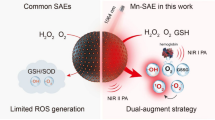Abstract
Chemodynamic therapy (CDT) is well acknowledged as potent reactive oxygen species (ROS)-mediated anticancer strategy. Especially, the study about labile iron pool (LIP) as endogenous ferrous catalyzer has paved the way for future CDT development. However, limited H2O2 expression, mild acidity, reduced glutathione (GSH) ablation of ROS, etc., all require employing alternate peroxo-complex to achieve enhanced CDT effect. As a non-Fenton-type substrate, artesunate (ART) has been utilized as a source of free radicals through decomposition of endoperoxide bridges catalyzed by ferrous ions, nonetheless, the non-tumor-specific delivery, inferior pharmacokinetics, and hydrophobic nature minimize the efficacy of ART in physiological systems. Herein, we devise a PPA nanoamplifier by conjugating ART with PEG-functionalized Pd@Pt nanoplates (PP NPs) to form ester linkage, ensuring specific intratumoral esterase-responsive ART release. Significantly, the PPA nanoamplifier combines the in situ decomposition of ART’s endoperoxide bridges by Fe2+ to superoxide anions (O2·−) and peroxidase (POD)-like enzymatic catalysis of endogenous H2O2 by PP to hydroxyl radicals (·OH), thus achieving amplified ROS-mediated tumor therapy. Besides, PPA displays GSH destruction potential, thereby protecting ROS from the cleavage by GSH oxidation. In addition, the strong absorption of PPA in near-infrared (NIR) region also endows PPA with photoacoustic property to realize imaging-guided CDT. In short, by taking advantages of the high enrichment and esterase- responsive drug release at tumor sites, PPA amplified ROS signals via dual pathways, killing tumor cells in vitro and inhibiting tumor growth in vivo, thereby realizing high-efficiency non-Fenton CDT. We believe our novel anti-tumor strategy based on PPA will broaden the future of ROS-mediated tumor-targeted therapy.

Similar content being viewed by others
References
Tang, Z. M.; Liu, Y. Y.; He, M. Y.; Bu, W. B. Chemodynamic therapy: Tumour microenvironment-mediated fenton and fenton-like reactions. Angew. Chem., Int. Ed. 2019, 58, 946–956.
Deák, M.; Horváth, G. V.; Davletova, S.; Török, K.; Sass, L.; Vass, I.; Barna, B.; Kirády, Z.; Dudits, D. Plants ectopically expressing the ironbinding protein, ferritin, are tolerant to oxidative damage and pathogens. Nat. Biotechnol. 1999, 17, 192–196.
Shi, Z.; Zhang, Y.; Duoerkun, G.; Cao, W.; Liu, T.; Zhang, L. S.; Liu, J. S.; Li, M. Q.; Chen, Z. G. Fabrication of MoS2/BiOBr heterojunctions on carbon fibers as a weaveable photocatalyst for tetracycline hydrochloride degradation and Cr(VI) reduction under visible light. Environ. Sci. Nano 2020, 7, 2708–2722.
Liu, J. N.; Bu, W. B.; Shi, J. L. Chemical design and synthesis of functionalized probes for imaging and treating tumor hypoxia. Chem. Rev. 2017, 117, 6160–6224.
Li, S. S.; Shang, L.; Xu, B. L.; Wang, S. H.; Gu, K.; Wu, Q. Y.; Sun, Y.; Zhang, Q. H.; Yang, H. L.; Zhang, F. R. et al. A nanozyme with photo-enhanced dual enzyme-like activities for deep pancreatic cancer therapy. Angew. Chem., Int. Ed. 2019, 58, 12624–12631.
Zhang, C.; Bu, W. B.; Ni, D. L.; Zhang, S. J.; Li, Q.; Yao, Z. W.; Zhang, J. W.; Yao, H. L.; Wang, Z.; Shi, J. L. Synthesis of iron nanometallic glasses and their application in cancer therapy by a localized fenton reaction. Angew. Chem., Int. Ed. 2016, 55, 2101–2106.
Shevtsov, M. A.; Parr, M. A.; Ryzhov, V. A.; Zemtsova, E. G.; Arbenin, A. Y.; Ponomareva, A. N.; Smirnov, V. M.; Multhoff, G. Zero-valent Fe confined mesoporous silica nanocarriers (Fe(0)@MCM-41) for targeting experimental orthotopic glioma in rats. Sci. Rep. 2016, 6, 29247.
Lei, S.; Chen, J. X.; Zeng, K.; Wang, M. Z.; Ge, X. W. Visual dual chemodynamic/photothermal therapeutic nanoplatform based on superoxide dismutase plus Prussian blue. Nano Res. 2019, 12, 1071–1082.
Wu, W. C.; Yu, L. D.; Jiang, Q. Z.; Huo, M. F.; Lin, H.; Wang, L. Y.; Chen, Y.; Shi, J. L. Enhanced tumor-specific disulfiram chemotherapy by in situ Cu2+ chelation-initiated nontoxicity-to-toxicity transition. J. Am. Chem. Soc. 2019, 141, 11531–11539.
Yin, S. Y.; Song, G. S.; Yang, Y.; Zhao, Y.; Wang, P.; Zhu, L. M.; Yin, X.; Zhang, X. B. Persistent regulation of tumor microenvironment via circulating catalysis of MnFe2O4@metal-organic frameworks for enhanced photodynamic therapy. Adv. Funct. Mater. 2019, 29. 1901417.
Lin, L. S.; Song, J. B.; Song, L.; Ke, K. M.; Liu, Y. J.; Zhou, Z. J.; Shen, Z. Y.; Li, J.; Yang, Z.; Tang, W. et al. Simultaneous Fenton-like ion delivery and glutathione depletion by MnO2-based nanoagent to enhance chemodynamic therapy. Angew. Chem., Int. Ed. 2018, 57, 4902–4906.
Gao, S. T.; Jin, Y.; Ge, K.; Li, Z. H.; Liu, H. F.; Dai, X. Y.; Zhang, Y. H.; Chen, S. Z.; Liang, X. J.; Zhang, J. C. Self-supply of O2 and H2O2 by a nanocatalytic medicine to enhance combined chemo/chemodynamic therapy. Adv. Sci. 2019, 6, 1902137.
Fu, S. Y.; Yang, R. H.; Zhang, L.; Liu, W. W.; Du, G. Y.; Cao, Y.; Xu, Z.G.; Cui, H. J.; Kang, Y. J.; Xue, P. Biomimetic CoO@AuPt nanozyme responsive to multiple tumor microenvironmental clues for augmenting chemodynamic therapy. Biomaterials 2020, 257, 120279.
Lin, L. S.; Wang, S.; Deng, H. Z.; Yang, W. J.; Rao, L.; Tian, R.; Liu, Y.; Yu, G. C.; Zhou, Z. J.; Song, J. B. et al. Endogenous labile iron pool-mediated free radical generation for cancer chemodynamic therapy. J. Am. Chem. Soc. 2020, 142, 15320–15330.
Trachootham, D.; Alexandre, J.; Huang, P. Targeting cancer cells by ROS-mediated mechanisms: A radical therapeutic approach? Nat. Rev. Drug Discov. 2009, 8, 579–591.
Zheng, G.; Chen, J.; Stefflova, K.; Jarvi, M.; Li, H.; Wilson, B. C. Photodynamic molecular beacon as an activatable photosensitizer based on protease-controlled singlet oxygen quenching and activation. Proc. Natl. Acad. Sci. USA 2007, 104, 8989–8994.
Yang, G. B.; Xu, L. G.; Chao, Y.; Xu, J.; Sun, X. Q.; Wu, Y. F.; Peng, R.; Liu, Z. Hollow MnO2 as a tumor-microenvironment-responsive biodegradable nano-platform for combination therapy favoring antitumor immune responses. Nat. Commun. 2017, 8, 902.
Fan, Z. X.; Jiang, B. L.; Zhu, Q. X.; Xiang, S. J.; Tu, L.; Yang, Y. F.; Zhao, Q. L.; Huang, D. D.; Han, J.; Su, G. H. et al. Tumor-specific endogenous FeII-activated, MRI-guided self-targeting gadolinium-coordinated theranostic nanoplatforms for amplification of ROS and enhanced chemodynamic chemotherapy. ACS Appl. Mater. Interfaces 2020, 12, 14884–14904.
Zhong, X. Y.; Wang, X. W.; Cheng, L.; Tang, Y. A.; Zhan, G. T.; Gong, F.; Zhang, R.; Hu, J.; Liu, Z.; Yang, X. L. GSH-depleted PtCu3 nanocages for chemodynamic-enhanced sonodynamic cancer therapy. Adv. Funct. Mater. 2020, 30, 1907954.
Chen, Z. G.; Kang, X. X.; Wu, Y. X.; Xiao, H. H.; Cai, X. Z.; Sheng, S. H.; Wang, X. F.; Chen, S. G. A mitochondria targeting artesunate prodrug-loaded nanoparticle exerting anticancer activity via iron-mediated generation of the reactive oxygen species. Chem. Commun. 2019, 55, 4781–4784.
Wong, Y. K.; Xu, C. C.; Kalesh, K. A.; He, Y. K.; Lin, Q. S.; Wong, W. S. F.; Shen, H. M.; Wang, J. G. Artemisinin as an anticancer drug: Recent advances in target profiling and mechanisms of action. Med. Res. Rev. 2017, 37, 1492–1517.
Greenshields, A. L.; Shepherd, T. G.; Hoskin, D. W. Contribution of reactive oxygen species to ovarian cancer cell growth arrest and killing by the anti-malarial drug artesunate. Mol. Carcinog. 2017, 56, 75–93.
Wei, S. P.; Liu, L. L.; Chen, Z. Y.; Yin, W. L.; Liu, Y. Z.; Ouyang, Q. Y.; Zeng, F. Y.; Nie, Y. J.; Chen, T. Artesunate inhibits the mevalonate pathway and promotes glioma cell senescence. J. Cell Mol. Med. 2020, 24, 276–284.
Torti, S. V.; Torti, F. M. Ironing out cancer. Cancer Res. 2011, 71, 1511–1514.
Chen, J.; Wang, X. B.; Zhang, Y.; Zhang, S. R.; Liu, H. L.; Zhang, J. X.; Feng, H.; Li, B.; Wu, X. Y.; Gao, Y. J. et al. A redox-triggered C-centered free radicals nanogenerator for self-enhanced magnetic resonance imaging and chemodynamic therapy. Biomaterials 2021, 266, 120457.
Yiu, H. H. P.; Wright, P. A.; Botting, N. P. Enzyme immobilisation using SBA-15 mesoporous molecular sieves with functionalised surfaces. J. Mol. Catal. B Enzym. 2001, 15, 81–92.
Kannan, R.; Kumar, K.; Sahal, D.; Kukreti, S.; Chauhan, V. S. Reaction of artemisinin with haemoglobin: Implications for antimalarial activity. Biochem. J. 2005, 385, 409–418.
Amolegbe, S. A.; Ohmagari, H.; Wakata, K.; Takehira, H.; Ohtani, R.; Nakamura, M.; Yu, C. Z.; Hayami, S. Synthesis of mesoporous materials as nano-carriers for an antimalarial drug. J. Mater. Chem. B 2016, 4, 1040–1043.
Hou, L.; Shan, X. N.; Hao, L. S.; Feng, Q. H.; Zhang, Z. Z. Copper sulfide nanoparticle-based localized drug delivery system as an effective cancer synergistic treatment and theranostic platform. Acta Biomater. 2017, 54, 307–320.
Jin, M. H.; Shen, X. S.; Zhao, C. X.; Qin, X. L.; Liu, H. F.; Huang, L. F.; Qiu, Z. P.; Liu, Y. In vivo study of effects of artesunate nanoliposomes on human hepatocellular carcinoma xenografts in nude mice. Drug Deliv. 2013, 20, 127–133.
Guo, Z. D.; Yang, L.; Chen, M.; Wen, X. J.; Liu, H. H.; Li, J. C.; Xu, D.; An, Y. Y.; Shi, C. R.; Li, J. D. et al. Molecular imaging of advanced atherosclerotic plaques with folate receptor-targeted 2D nanoprobes. Nano Res. 2020, 13, 173–182.
Sun, D.; Pang, X.; Cheng, Y.; Ming, J.; Xiang, S. J.; Zhang, C.; Lv, P.; Chu, C. C.; Chen, X. L.; Liu, G. et al. Ultrasound-switchable nanozyme augments sonodynamic therapy against multidrug-resistant bacterial infection. ACS Nano 2020, 14, 2063–2076.
Ming, J.; Zhu, T. B.; Yang, W. H.; Shi, Y. R.; Huang, D. D.; Li, J. C.; Xiang, S. J.; Wang, J. J.; Chen, X. L.; Zheng, N. F. Pd@Pt-GOx/HA as a novel enzymatic cascade nanoreactor for high-efficiency starving-enhanced chemodynamic cancer therapy. ACS Appl. Mater. Interfaces 2020, 12, 51249–51262.
Wei, J. P.; Chen, X. L.; Shi, S. G.; Mo, S. G.; Zheng, N. F. An investigation of the mimetic enzyme activity of two-dimensional Pd-based nanostructures. Nanoscale 2015, 7, 19018–19026.
Qiu, N. S.; Liu, X. R.; Zhong, Y.; Zhou, Z. X.; Piao, Y.; Miao, L.; Zhang, Q. Z.; Tang, J. B.; Huang, L.; Shen, Y. Q. Esterase-activated charge-reversal polymer for fibroblast-exempt cancer gene therapy. Adv. Mater. 2016, 28, 10613–10622.
Huang, X. Q.; Tang, S. H.; Mu, X. L.; Dai, Y.; Chen, G. X.; Zhou, Z. Y.; Ruan, F. X.; Yang, Z. L.; Zheng, N. F. Freestanding palladium nanosheets with plasmonic and catalytic properties. Nat. Nanotechnol. 2011, 6, 28–32.
Wei, J. P.; Li, J. C.; Sun, D.; Li, Q.; Ma, J. Y.; Chen, X. L.; Zhu, X.; Zheng, N. F. A novel theranostic nanoplatform based on Pd@Pt-PEG-Ce6 for enhanced photodynamic therapy by modulating tumor hypoxia microenvironment. Adv. Funct. Mater. 2018, 28, 1706310.
Larsen, E. M.; Johnson, R. J. Microbial esterases and ester prodrugs: An unlikely marriage for combating antibiotic resistance. Drug Dev. Res. 2019, 80, 33–47.
Ding, C. Z.; Li, Z. B. A review of drug release mechanisms from nanocarrier systems. Mat. Sci. Eng. C 2017, 76, 1440–1453.
Gao, L. Z.; Zhuang, J.; Nie, L.; Zhang, J. B.; Zhang, Y.; Gu, N.; Wang, T. H.; Feng, J.; Yang, D. L.; Perrett, S. et al. Intrinsic peroxidase-like activity of ferromagnetic nanoparticles. Nat. Nanotechnol. 2007, 2, 577–583.
Zhang, W.; Hu, S. L.; Yin, J. J.; He, W. W.; Lu, W.; Ma, M.; Gu, N.; Zhang, Y. Prussian blue nanoparticles as multienzyme mimetics and reactive oxygen species scavengers. J. Am. Chem. Soc. 2016, 138, 5860–5865.
Wan, X. Y.; Zhong, H.; Pan, W.; Li, Y. H.; Chen, Y. Y.; Li, N.; Tang, B. Programmed release of dihydroartemisinin for synergistic cancer therapy using a CaCO3 mineralized metal-organic framework. Angew. Chem., Int. Ed. 2019, 58, 14134–14139.
Zhu, M. T.; Nie, G. J.; Meng, H.; Xia, T.; Nel, A.; Zhao, Y. L. Physicochemical properties determine nanomaterial cellular uptake, transport, and fate. Acc. Chem. Res. 2013, 46, 622–631.
Yin, J.; Kwon, Y.; Kim, D.; Lee, D.; Kim, G.; Hu, Y.; Ryu, J. H.; Yoon, J. Cyanine-based fluorescent probe for highly selective detection of glutathione in cell cultures and live mouse tissues. J. Am. Chem. Soc. 2014, 136, 5351–5358.
Geng, P.; Yu, N.; Zhang, J. L.; Jin, Z. L.; Wen, M.; Jiang, Q.; Kang, L.; Peng, C.; Li, M. Q.; Zhang, H. J. et al. One responsive stone, three birds: Mn(III)-hemoporfin frameworks with glutathione-enhanced degradation, MRI, and sonodynamic therapy. Adv. Healthc. Mater. 2021, 10, 2001463.
Zhang, A. M.; Zhang, Q.; Alfranca, G.; Pan, S. J.; Huang, Z. C.; Cheng, J.; Ma, Q.; Song, J.; Pan, Y. X.; Ni, J. et al. Gsh-triggered sequential catalysis for tumor imaging and eradication based on star-like au/pt enzyme carrier system. Nano Res. 2020, 13, 160–172.
Zhang, Q. F.; Kuang, G. Z.; He, S. S.; Liu, S.; Lu, H. T.; Li, X. Y.; Zhou, D. F.; Huang, Y. B. Chain-shattering Pt(IV)-backboned polymeric nanoplatform for efficient CRISPR/Cas9 gene editing to enhance synergistic cancer therapy. Nano Res. 2021, 14, 601–610.
Visavadiya, N. P.; Patel, S. P.; VanRooyen, J. L.; Sullivan, P. G.; Rabchevsky, A. G. Cellular and subcellular oxidative stress parameters following severe spinal cord injury. Redox Biol. 2016, 8, 59–67.
Kryston, T. B.; Georgiev, A. B.; Pissis, P.; Georgakilas, A. G. Role of oxidative stress and DNA damage in human carcinogenesis. Mutat. Res. 2011, 711, 193–201.
Zheng, D. W.; Lei, Q.; Zhu, J. Y.; Fan, J. X.; Li, C. X.; Li, C.; Xu, Z. S.; Cheng, S. X.; Zhang, X. Z. Switching apoptosis to ferroptosis: Metal-organic network for high-efficiency anticancer therapy. Nano Lett. 2017, 17, 284–291.
Miao, Z. H.; Chen, S.; Xu, C. Y.; Ma, Y.; Qian, H. S.; Xu, Y. J.; Chen, H. J.; Wang, X. W.; He, G.; Lu, Y. et al. PEGylated rhenium nanoclusters: A degradable metal photothermal nanoagent for cancer therapy. Chem. Sci. 2019, 10, 5435–5443.
Zhang, C.; Bu, W. B.; Ni, D. L.; Zuo, C. J.; Chang, C.; Li, Q.; Zhang, L. L.; Wang, Z.; Shi, J. L. A polyoxometalate cluster paradigm with self-adaptive electronic structure for acidity/reducibility-specific photothermal conversion. J. Am. Chem. Soc. 2016, 138, 8156–8164.
Acknowledgements
This work was financially supported by the National Natural Science Foundation of China (Nos. 22075233 and 82073405), and Fundamental Research Funds for the Central Universities (Nos. 20720200020 and 20720190150). We acknowledge the support from Prof. Nanfeng Zheng from Xiamen University.
Author information
Authors and Affiliations
Corresponding authors
Electronic Supplementary Material
12274_2021_3574_MOESM1_ESM.pdf
Endogenous Fe2+-activated ROS nanoamplifier for esteraseresponsive and photoacoustic imaging-monitored therapeutic improvement
Rights and permissions
About this article
Cite this article
Xiang, S., Fan, Z., Ye, Z. et al. Endogenous Fe2+-activated ROS nanoamplifier for esterase-responsive and photoacoustic imaging-monitored therapeutic improvement. Nano Res. 15, 907–918 (2022). https://doi.org/10.1007/s12274-021-3574-x
Received:
Revised:
Accepted:
Published:
Issue Date:
DOI: https://doi.org/10.1007/s12274-021-3574-x




